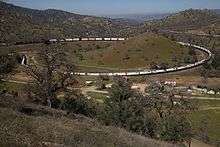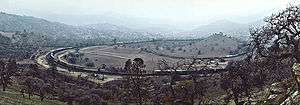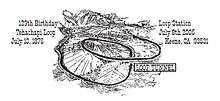Tehachapi Loop
The Tehachapi Loop is a 0.73 miles (1.17 km) long spiral, or helix, on the Union Pacific Railroad Mojave Subdivision through Tehachapi Pass, of the Tehachapi Mountains in Kern County, south-central California. The line connects Bakersfield and the San Joaquin Valley to Mojave in the Mojave Desert.





Rising at a steady two percent grade, the track gains 77 feet (23 m) in elevation in the Loop.[1] Any train more than 4,000 feet (1,200 m) long passes over itself going around the loop. At the bottom of the loop, the track passes through Tunnel 9, the ninth tunnel built as the railroad worked from Bakersfield.
The line averages approximately 40 trains each day. Due to its frequent trains and scenic setting, the Tehachapi Loop is popular with railfans. In 1998 it was named a National Historic Civil Engineering Landmark and is designated as California Historical Landmark #508.[2]
History
One of the engineering feats of its day, the Loop was built by Southern Pacific Railroad to ease the grade over Tehachapi Pass. Construction began in 1874, and the line opened in 1876.[3] Contributors to the project's construction include Arthur De Wint Foote and the project's chief engineer, William Hood.[4]
The siding on the loop is known as Walong after Southern Pacific District Roadmaster W. A. Long.[5][6]
The project was constructed under the leadership of Southern Pacific's civil engineers, James R. Strobridge and William Hood, using a predominantly Chinese labor force. The Tehachapi Loop took under two years to complete, featuring 18 tunnels, 10 bridges, and numerous water towers for the steam locomotives. Between 1875-76 about 3,000 Chinese workers equipped with little more than hand tools, picks, shovels, horse-drawn carts and blasting powder cut through solid and decomposed granite to create the helix-shaped 0.73 mile loop with grades averaging about 2.2 percent and an elevation gain of 77 feet. In 1882 the line was extended through Southern California and the Mojave Desert with 8,000 Chinese men working under Strobridge and another man. Both of the men came out of retirement after working on the Central Pacific Railroad.
A large white cross, "The Cross at the Loop", stands atop the hill in the center of the loop in memory of two Southern Pacific Railroad employees killed on May 12, 1989, in a train derailment in San Bernardino, California.[3]
The Tehachapi Depot Museum stands in the nearby town of Tehachapi.
Operations
The Loop became the property of the Union Pacific in 1996, when the Union Pacific and Southern Pacific systems merged. Trains of the BNSF Railway also use the loop under trackage rights.
Although Southern Pacific ran passenger trains on the Loop for years, it banned passenger service there soon after handing its trains to Amtrak in 1971. Union Pacific has maintained the ban since taking over Southern Pacific. As a result, Amtrak's San Joaquin train is unable to directly serve Los Angeles.[7] Amtrak operates Thruway Motorcoach buses for passengers wanting to travel between the Central Valley and Los Angeles.
An exception is made for the Coast Starlight, which uses the line as a detour if its normal route is closed.[8]
See also
- Spiral (railway) for many other loops.
References
- Ande, Howard (2010). "Tehachapi in the 21st Century". NRHS Bulletin. National Railway Historical Society. 75 (Spring 2010): 4–21.
- "Tehachapi Loop". Office of Historic Preservation, California State Parks. Retrieved October 7, 2012.
- "Tehachapi Loop history". Tehachapi_online. Archived from the original on November 18, 2011. Retrieved December 1, 2011.
- Rickard, Thomas Arthur (1922). Interviews with Mining Engineers. San Francisco: Mining and Scientific Press. p. 172. OCLC 2664362.
Arthur De Wint Foote.
- Jenkins, Jim C. & Jenkins, Ruby Johnson (1995). Exploring the Southern Sierra, West Side. Wilderness Press. p. 23. ISBN 0-89997-181-4.
- Durham, David L. (1998). California's Geographic Names. Quill Driver Books. p. 1124. ISBN 1-884995-14-4.
- Christopher McFadden (February 11, 2017). "Going Round the Bend with the Tehachapi Loop".
- "Passenger trains will be diverted over Tehachapi Loop". Tehachapi News. 1 March 2013.
External links
| Wikimedia Commons has media related to Tehachapi Loop. |
- New aerial video of the 2nd track improvement, Nov 2016
- Aerial video of 4000' train going uphill through the loop Nov 2015
- Trainweb.org: Tehachapi Loop - Map and Railfan Info
- Tehachapi Loop - A Brief History
- Tehachapi Loop Photos
- Photo Gallery of Tehachapi Loop shots
- HO Scale Model at the San Diego Model Railroad Museum
- Stay In The Loop - Tehachapi News & Entertainment
- Aerial video of BNSF train traversing Tehachapi Loop
- A photographic report of Tehachapi and Cajon Pass (May, 2012)